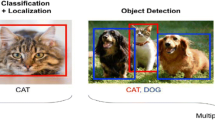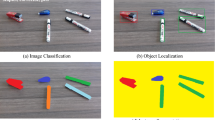Abstract
In this article, we present an algorithm that can efficiently track the contour extracted from silhouette of the moving object of a given video sequence using local neighborhood information and fuzzy k-nearest-neighbor classifier. To classify each unlabeled sample in the target frame, instead of considering the whole training set, a subset of it is considered depending on the amount of motion of the object between immediate previous two consecutive frames. This technique makes the classification process faster and may increase the classification accuracy. Classification of the unlabeled samples in the target frame provides object (silhouette of the object) and background (non-object) regions. Transition pixels from the non-object region to the object silhouette and vice versa are treated as the boundary or contour pixels of the object. Contour or boundary of the object is extracted by connecting the boundary pixels and the object is tracked with this contour in the target frame. We show a realization of the proposed method and demonstrate it on eight benchmark video sequences. The effectiveness of the proposed method is established by comparing it with six state of the art contour tracking techniques, both qualitatively and quantitatively.
















Similar content being viewed by others
References
Aitfares W, Bouyakhf E, Herbulot A, Regragui F, Devy M (2013) Hybrid region and interest points-based active contour for object tracking. Appl Math Sci 7(118):5879–5899
Allili MS, Ziou D (2008) Object tracking in videos using adaptive mixture models and active contours. Neurocomputing 71:2001–2011
Avidan S (2004) Support vector tracking. IEEE Trans Pattern Anal Mach Intell 26(8):1064–1072
Avidan S (2007) Ensemble tracking. IEEE Trans Pattern Anal Mach Intell 29(2):261–271
Babenko B, Yang M, Belongie S (2011) Robust object tracking with online multiple instance learning. IEEE Trans Pattern Anal Mach Intell 33(8):1619–1632
Baumann A, Boltz M, Ebling J, Koenig M, Loos HS, Merkel M, Niem W, Warzelhan JK, Yu J (2008) A review and comparison of measures for automatic video surveillance systems. EURASIP J Image Video Process 2008(824726):1–30
Bovic AL (2000) Image and video processing. Academic Press, New York
Brox T, Rousson M, Deriche RD, Weickert J (2010) Colour, texture, and motion in level set based segmentation and tracking. Image Vis Comput 28(3):376–390
Caselles V (1995) Geometric models for active contours. In: International conference on image processing, vol 3, pp 9–12
Caselles V, Kimmel R, Sapiro G (1997) Geodesic active contours. Int J Comput Vis 22(1):61–79
Chiverton J, Xie X, Mirmehdi M (2012) Automatic bootstrapping and tracking of object contours. IEEE Trans Image Process 21(3):1231–1245
Cohen LD (1991) On active contour models and balloons. Image Underst 53(2):211–218
Collins RT, Liu Y, Leordeanu M (2005) Online selection of discriminative tracking features. IEEE Trans Pattern Anal Mach Intell 27(10):1631–1643
Dalal N, Triggs B (2005) Histograms of oriented gradients for human detection. In: Proceedings of the 2005 IEEE Computer Society conference on computer vision and pattern recognition, vol 1, pp 886–893
Freeman WT, Roth M (1995) Orientation histograms for hand gesture recognition. In: IEEE international workshop on automatic face and gesture recognition, pp 296–301
Ghosh A, Subudhi BN, Ghosh S (2012) Object detection from videos captured by moving camera by fuzzy edge incorporated Markov Random Field and local histogram matching. IEEE Trans Circuits Syst Video Technol 2(8):1127–1135
Gonzalez RF, Woods RE (2008) Digital image processing. Pearson Education, Singapore
Grabner H, Grabner M, Bischof H (2006) Real-time tracking via on-line boosting. In: Proceedings of the British machine vision conference, vol 1, pp 47–56
Kass M, Witkin A, Terzopoulos D (1988) Snakes: active contour models. Int J Comput Vis 1(4):321–331
Kasturi R, Goldgof D, Soundararajan P, Manohar V, Garofolo J, Bowers R, Boonstra M, Korzhova V, Zhang J (2009) Framework for performance evaluation of face, text, and vehicle detection and tracking in video: data, metrics and protocol. IEEE Trans Pattern Anal Mach Intell 31(2):319–336
Keller JM, Gray MR, Givens JA (1985) A fuzzy k-nearest neighbor algorithm. IEEE Trans Syst Man Cybernet 15(4):580–585
Lazarevic-McManus N, Renno JR, Makris D, Jones GA (2008) An object-based comparative methodology for motion detection based on the f-measure. Comput Vis Image Underst 111(1):74–85
Lefévre S, Gerard JP, Piron A, Vincent N (2002) An extended snake model for real-time multiple object tracking. In: International workshop on advanced concepts for intelligent vision systems, pp 268–275
Levi K, Weiss Y (2004) Learning object detection from a small number of examples: the importance of good features. In: Proceedings of the 2004 IEEE Computer Society conference on computer vision and pattern recognition, vol 2, pp 53–60
Luo S, Li R, Ourselin S (2003) A new deformable model using dynamic gradient vector flow and adaptive balloon forces. In: APRS workshop on digital computing, pp 9–14
Malladi R, Sethian JA, Vemuri BC (1995) Shape modeling with front propagation: a level set approach. IEEE Trans Pattern Anal Mach Intell 17(2):158–175
Nguyen HT, Worring M, van den Boomgaard R, Smeulders A (2002) Tracking non-parameterized object contours in video. IEEE Trans Image Process 11(9):1081–1091
Ning J, Zhang L, Zhang D, Yu W (2013) Joint registration and active contour segmentation for object tracking. IEEE Trans Circuits Syst Video Technol 23(9):1589–1597
Osher S, Sethian JA (1998) Fronts propagating with curvature dependent speed: algorithms based on Hamilton–Jacobi formulations. J Comput Phys 79(1):12–49
Paragios N, Mellina-Gottardo O, Ramesh V (2004) Gradient vector flow fast geometric active contours. IEEE Trans Pattern Anal Mach Intell 26(3):402–407
Santner J, Leistner C, Saffari A, Pock T, Bischof H (2010) PROST: parallel robust online simple tracking. In: 2010 IEEE conference on computer vision and pattern recognition (CVPR), pp 723–730
Suard F, Rakotomamonjy A, Bensrhair A (2006) Pedestrian detection using infrared images and histograms of oriented gradients. In: IEEE conference on intelligent vehicles, pp 206–212
Tang F, Brennan S, Zhao Q, Tao H (2007) Co-tracking using semi-supervised support vector machines. In: IEEE 11th international conference on computer vision, pp 1–8
Tekalp AM (1995) Digital video processing. Prentice Hall, New Jersey
Xu C, Prince JL (1998) Snakes, shapes, and gradient vector flow. IEEE Trans Image Process 7(3):359–369
Yilmaz A, Li X, Shah M (2004) Contour-based object tracking with occlusion handling in video acquired using mobile cameras. IEEE Trans Pattern Anal Mach Intell 26(11):1–6
Yilmaz A, Javed O, Shah M (2006) Object tracking: a survey. ACM Comput Surv 38(4):1264–1291
Acknowledgments
The authors like to thank the reviewers for their thorough and constructive comments, which helped a lot to enhance the quality of the manuscript. Funding by U. S. Army through the project “Processing and Analysis of Aircraft Images with Machine Learning Techniques for Locating Objects of Interest” (Contract No. FA5209-08-P-0241) is also gratefully acknowledged.
Author information
Authors and Affiliations
Corresponding author
Additional information
Communicated by V. Loia.
Rights and permissions
About this article
Cite this article
Mondal, A., Ghosh, S. & Ghosh, A. Efficient silhouette-based contour tracking using local information. Soft Comput 20, 785–805 (2016). https://doi.org/10.1007/s00500-014-1543-y
Published:
Issue Date:
DOI: https://doi.org/10.1007/s00500-014-1543-y




